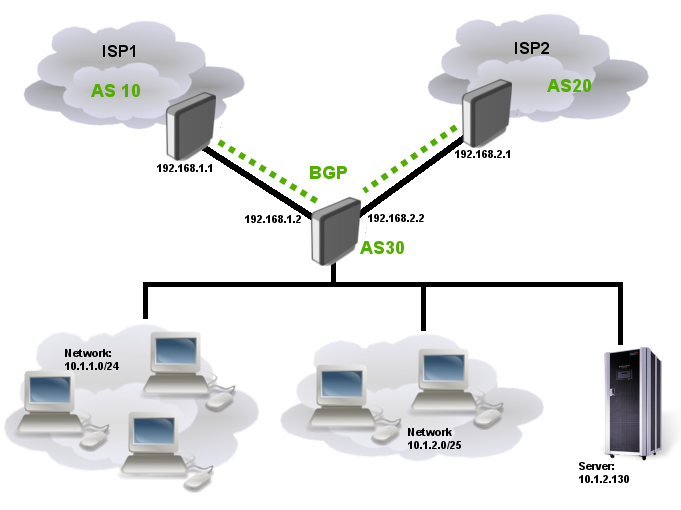Mikrotik: BGP Dua Link main backup - dengan MD5 Authentication
Jump to navigation
Jump to search
Ada tiga (3) ISP
ISP1:
IP 192.168.1.1/24 menuju ISP3 IP 192.168.3.1/24 menuju ISP2 AS 10 IP 10.100.100.0/24 IP 10.100.200.0/24
ISP2
IP 192.168.2.1/24 - menuju ISP3 IP 192.168.3.2/24 - menuju ISP1 AS 20 IP 10.10.10.0/24 IP 10.10.20.0/24
ISP3 (kita)
IP 192.168.1.2/24 - menuju ISP1 IP 192.168.2.2/24 - menuju ISP2 AS 30 IP 10.1.1.0/24 IP 10.1.2.0/24
Sambungan Fisik
ISP1
ISP1 ether0 -> ISP3 ether0 ISP1 ether1 -> ISP2 ether1 ISP2 ether0 -> ISP3 ether1 ISP1 ether2 10.100.100.1/24 ISP1 ether3 10.100.200.1/24 ISP2 ether2 10.10.10.1/24 ISP2 ether3 10.10.20.1/24 ISP3 ether2 10.1.1.1/24 ISP3 ether3 10.1.2.1/24
Setup connection
ISP1
/ip address add interface=ether1 address=192.168.1.1/24 /ip address add interface=ether2 address=192.168.3.1/24 /ip address add interface=ether3 address=10.100.100.1/24 /ip address add interface=ether3 address=10.100.200.1/24
ISP2
/ip address add interface=ether1 address=192.168.2.1/24 /ip address add interface=ether2 address=192.168.3.2/24 /ip address add interface=ether3 address=10.10.10.1/24 /ip address add interface=ether4 address=10.10.20.1/24
ISP3
/ip address add interface=ether1 address=192.168.1.2/24 /ip address add interface=ether2 address=192.168.2.2/24 /ip address add interface=ether3 address=10.1.1.1/24 /ip address add interface=ether4 address=10.1.2.1/24
BGP Peering
Consider that IP connectivity between ISPs edge routers and Our Core router is already set up and working properly. So we can start to establish BGP peering to both ISPs.
ISP1:
#set our AS number /routing bgp instance set default as=10 #add BGP peers /routing bgp peer add name=toISP2 remote-address=192.168.3.2 remote-as=20 tcp-md5-key=$AP7i1 add name=toISP3 remote-address=192.168.1.2 remote-as=30 tcp-md5-key=$AP7i1 # jika ingin redistribute default route ke client yang spesifik # add name=toISP2 remote-address=192.168.3.2 remote-as=20 default-originate=if-installed # add name=toISP3 remote-address=192.168.1.2 remote-as=30 default-originate=if-installed # # advertize routing # /routing bgp network add network=10.100.100.0/24 synchronize=no add network=10.100.200.0/24 synchronize=no
ISP2:
#set our AS number /routing bgp instance set default as=20 #add BGP peers /routing bgp peer add name=toISP1 remote-address=192.168.3.1 remote-as=10 tcp-md5-key=$AP7i1 add name=toISP3 remote-address=192.168.2.2 remote-as=30 tcp-md5-key=$AP7i1 # # advertize routing # /routing bgp network add network=10.10.10.0/24 synchronize=no add network=10.10.20.0/24 synchronize=no
ISP3:
#set our AS number /routing bgp instance set default as=30 #add BGP peers /routing bgp peer add name=toISP1 remote-address=192.168.1.1 remote-as=10 tcp-md5-key=$AP7i1 add name=toISP2 remote-address=192.168.2.1 remote-as=20 tcp-md5-key=$AP7i1 # # advertize routing # /routing bgp network add network=10.1.1.0/24 synchronize=no add network=10.1.2.0/24 synchronize=no
Main/Backup link setup
ISP3
/ip route add gateway=192.168.1.1 check-gateway=ping add gateway=192.168.2.1 distance=30 check-gateway=ping
Cek
/routing filter print /routing bgp instance print /routing bgp peer print status /routing bgp peer print /routing bgp advertisements print /ip route print
Referensi
- https://www.cisco.com/c/en/us/td/docs/ios-xml/ios/iproute_bgp/configuration/xe-16/irg-xe-16-book/configuring-a-basic-bgp-network.html
- https://wiki.mikrotik.com/wiki/Manual:Simple_BGP_Multihoming
